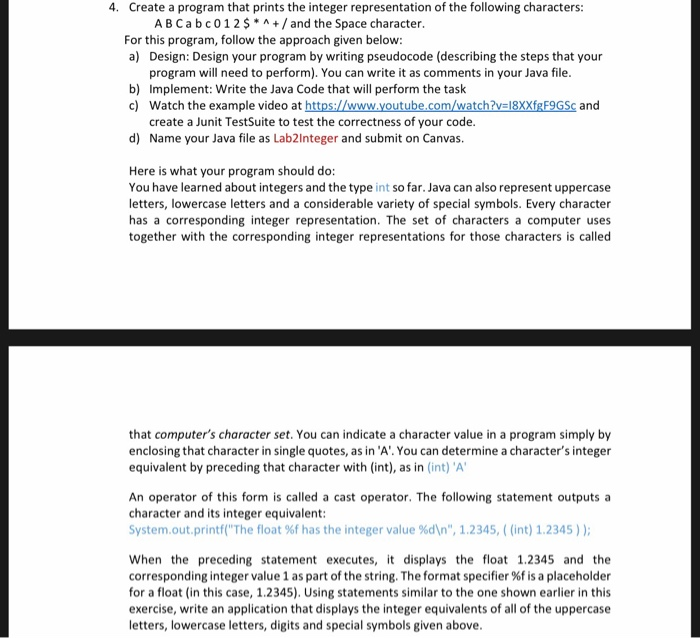Java

4. Create a program that prints the integer representation of the following characters: A B C a b c 0 1 2 $ * ^ +/ and the space character For this program, follow the approach given below: a) Design: Design your program by writing pseudocode (describing the steps that your program will need to perform). You can write it as comments in your Java file b) Implement: Write the Java Code that will perform the task c) Watch the example video at and create a Junit TestSuite to test the correctness of your code d) Name your Java file as Lab2Integer and submit on Canvas. Here is what your program should do: You have learned about integers and the type int so far. Java can also represent uppercase letters, lowercase letters and a considerable variety of special symbols. Every character has a corresponding integer representation. The set of characters a computer uses together with the corresponding integer representations for those characters is called that computer's character set. You can indicate a character value in a program simply by enclosing that character in single quotes, as in 'A'. You can determine a character's integer equivalent by preceding that character with (int), as in (int)A An operator of this form is called a cast operator. The following statement outputs a character and its integer equivalent: System.out.printf("The float %f has the integer value %d ", 1.2345, ( (int) 1.2345) ); When the preceding statement executes, it displays the oat 1.2345 and the corresponding integer value 1 as part of the string. The format specifier %f is a placeholder for a float (in this case, 1.2345). Using statements similar to the one shown earlier in this exercise, write an application that displays the integer equivalents of all of the uppercase letters, lowercase letters, digits and special symbols given above 4. Create a program that prints the integer representation of the following characters: A B C a b c 0 1 2 $ * ^ +/ and the space character For this program, follow the approach given below: a) Design: Design your program by writing pseudocode (describing the steps that your program will need to perform). You can write it as comments in your Java file b) Implement: Write the Java Code that will perform the task c) Watch the example video at and create a Junit TestSuite to test the correctness of your code d) Name your Java file as Lab2Integer and submit on Canvas. Here is what your program should do: You have learned about integers and the type int so far. Java can also represent uppercase letters, lowercase letters and a considerable variety of special symbols. Every character has a corresponding integer representation. The set of characters a computer uses together with the corresponding integer representations for those characters is called that computer's character set. You can indicate a character value in a program simply by enclosing that character in single quotes, as in 'A'. You can determine a character's integer equivalent by preceding that character with (int), as in (int)A An operator of this form is called a cast operator. The following statement outputs a character and its integer equivalent: System.out.printf("The float %f has the integer value %d ", 1.2345, ( (int) 1.2345) ); When the preceding statement executes, it displays the oat 1.2345 and the corresponding integer value 1 as part of the string. The format specifier %f is a placeholder for a float (in this case, 1.2345). Using statements similar to the one shown earlier in this exercise, write an application that displays the integer equivalents of all of the uppercase letters, lowercase letters, digits and special symbols given above








